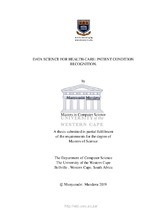| dc.description.abstract | The emergence of the Internet of Things (IoT) and Artificial Intelligence (AI) have elicited
increased interest in many areas of our daily lives. These include health, agriculture, aviation,
manufacturing, cities management and many others. In the health sector, portable vital
sign monitoring devices are being developed using the IoT technology to collect patients’ vital
signs in real-time. The vital sign data acquired by wearable devices is quantitative and machine
learning techniques can be applied to find hidden patterns in the dataset and help the medical
practitioner with decision making. There are about 30000 diseases known to man and no human
being can possibly remember all of them, their relations to other diseases, their symptoms
and whether the symptoms exhibited by the patients are early warnings of a fatal disease. In
light of this, Medical Decision Support Systems (MDSS) can provide assistance in making
these crucial assessments. In most decision support systems factors a ect each other; they can
be contradictory, competitive, and complementary. All these factors contribute to the overall
decision and have di erent degrees of influence [85]. However, while there is more need for automated
processes to improve the health-care sector, most of MDSS and the associated devices
are still under clinical trials. This thesis revisits cyber physical health systems (CPHS) with
the objective of designing and implementing a data analytics platform that provides patient
condition monitoring services in terms of patient prioritisation and disease identification [1].
Di erent machine learning algorithms are investigated by the platform as potential candidate
for achieving patient prioritisation. These include multiple linear regression, multiple logistic
regression, classification and regression decision trees, single hidden layer neural networks
and deep neural networks. Graph theory concepts are used to design and implement disease
identification. The data analytics platform analyses data from biomedical sensors and other
descriptive data provided by the patients (this can be recent data or historical data) stored in a
cloud which can be private local health Information organisation (LHIO) or belonging to a regional
health information organisation (RHIO). Users of the data analytics platform consisting
of medical practitioners and patients are assumed to interact with the platform through cities’
pharmacies , rural E-Health kiosks end user applications. | en_US |

